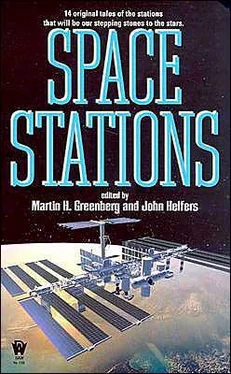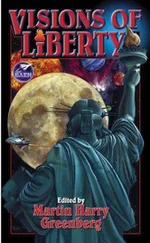The direct landing on the fourth planet was in part necessitated by the slowness of the journey using the Hohmann trajectory, in which the ship accelerated only at the beginning, then coasted along in free fall, and decelerated at the end of the journey to match Mars’ orbital velocity. It took so long getting there that the ship did not have sufficient reserve of consumables, which would have afforded the luxury of looking over the planet from an orbital altitude before landing. The ship needed to land without delay so that the crew could get at the provisions that had been dispatched to the landing site several months in advance.
One way to avoid the necessity of directly landing on Mars from Earth orbit was to shorten the travel time so that the ship would have ample provisions first to go into orbit around Mars and make certain that the landing would be safe. But it was all but impossible to do so with the conventional chemically powered rocket engines, which took so long in getting the crew to the destination. The ship could carry barely enough to keep the crew going for the nine months that it took to get there.
To shorten the travel time, it would be necessary to accelerate continuously for an extended period beyond the insertion to trans-Martian orbit. One way to do that was to use a nuclear powered rocket engine. It had turned out that the U.S. Air Force Space Command had been successful in developing an experimental nuclear fusion engine. Its early version had been proposed in the 1980s by Bussard at the time of the strategic defense initiative program; in its original form, the engine used protons, boron-11, lithium-6, deuterium, and helium-3 in appropriate cycles. This cycle did not emit neutrons, which made it safe for the human crew using this type of nuclear fusion engine. It had not been funded for development at the time but had later been picked up by the Space Command under the obscure budget heading of High-Efficiency Space Propulsion System. The label was not deceptive, as the nuclear fusion engine would be easily several times more efficient than chemical rockets in terms of the fuel mass involved. With a nuclear fusion engine of this type, it was possible to make it from Earth orbit to Mars orbit in just two months.
Just as importantly—perhaps even more significantly—placing the interplanetary ship on tiny Phobos first and sending a much smaller shuttle to the planetary surface meant that they would not have to expend a great deal of fuel to land the entire mass of the huge ship and lift it again from Mars for the return trip home. Instead, they would be landing and lifting the considerably smaller mass of the shuttle.
However, the phobia over using nuclear power was strong among the political parties in control of the leading countries in Europe that made up the ESA, as had sometimes been the case in the United States.
After the failure of the first manned mission to Mars, recognizing the immense advantages of using a fusion engine, the U.S. had broken away from the Consortium.
The U.S. manned mission to Mars had become a joint venture between the Air Force Space Command and NASA.
To show unity with the European Union, Russia had decided to stick with the
Consortium although historically Russia had had much fewer scruples about the use of nuclear power in space or elsewhere. Anchoring Mother Russia firmly to Western Europe was the sine qua non priority on their political agenda.
Japan left the Consortium when the multinational undertaking broke up with the departure of the U.S. and then joined the U.S. The most important reason for joining the U.S. expedition was perhaps the persuasive argument of the influential Japanese scientist, Professor Ikeda of the Institute of Space and Astronautical Science (ISAS), that the fusion engine and the plan to use Phobos as a space station before landing would give Trailblazer a substantially better chance of success than the Consortium’s Ares Mission. The Japanese also figured that chances of a Japanese astronaut to be chosen for the four-man crew of Ares would be low. The member states of the Consortium would all be vying for a seat for their nation and there were more than four leading European countries involved in the venture without even counting Russia. At that point, the U.S. made an irresistible offer to the Japanese; they would include a Japanese astronaut if Japan signed on.
Okita was a first-rate nuclear physicist and engineer from the Tokyo Institute of Technology, having done his postdoctorate work at the ISAS. He had also spent childhood years in the U.S. with his diplomat father and his biochemist mother who lectured at local universities wherever her husband was posted. In consequence, Okita spoke accentless Midwestern American and there would be no language barrier between him and his American teammates.
The Consortium expedition, called Ares I, had left Earth’s orbit about six months before the departure of Trailblazer I, but it was still on its way to Mars on a free-falling Hohmann orbit and was now actually behind Trailblazer. The Consortium had not given up on the thought of being the first on Mars and maybe counting on its competitor’s announced plan to convert Phobos into a space station first before attempting a landing on the Red Planet itself in their shuttle.
As Eriksen and Okita returned to Trailblazer, the ship’s planetary atmosphere specialist, Linde Hoerter, looked a little agitated. When she got really excited, which was not often, her Pennsylvania Dutch speech became noticeable. It was clear that she needed to talk to Eriksen in a hurry.
“Poul, I’ve been keeping a close watch on the Martian surface. There’s a possibility that a storm might be brewing near the area where the supply ship for Ares landed earlier Based on my analysis, this storm could become a nasty one. The timing is a little off from the storm season advocated by some experts on Earth, but these pesky events don’t follow any strict schedules anyway. We need to watch this one carefully before we dispatch Valkyrie to the surface.” The shuttle had been informally named Valkyrie by the captain, and his crew were all willing to oblige his whim.
Eriksen was his usual taciturn self. “You’ve told me before that no expert knows for sure how sandstorms get started. You are our expert. If we can’t depend on your prognosis, we have no one else to turn to. We’ll play it safe and heed your warning.”
After pausing a moment, he added, “Send a storm warning to Ares. They will be getting here in just a few days.”
“There could be a problem in getting them to pay attention to my warning.”
“Explain yourself, Linde.”
“Their Martian atmosphere expert, Roel van Dijk, does not agree with me on how a sandstorm gets started on Mars. He believes sandstorms occur only at the perihelion passage of Mars. As you know, Mars is already several months past perihelion. To complicate matters, there’s evidence that at least some sandstorms or dust devils are kicked up by falling meteoroids that are not burned up in the atmosphere; the Martian atmosphere is too thin to incinerate them. To be sure, falling meteorites could kick up dust and at least contribute to the storm. On this one issue, we have had many a running battle at scientific meetings over the years. He will probably advise Captain Ritter to reject our foul weather advisory. They are still trying to beat us and Ritter will have a strong motivation to listen to van Dijk.”
Eriksen pondered this a moment. “Send them a warning anyway. I would be damned if they did not have a warning from us before they made that crucial decision to land.”
An hour later, Eriksen received a reply from Ritter. The captain of Ares thanked Eriksen for the courtesy and would take the warning under advisement.
Eriksen considered the wording of the message. “Ritter might actually be thinking seriously about placing his ship in a parking orbit and watching a while if a big storm develops. On the other hand, he may be sandbagging us. If we think that Ares will be getting into a parking orbit, we’ll not be in a hurry to land Valkyrie. That will give them a chance to slip by us and land on Mars before us. Besides, getting into a parking orbit will cause them to use additional fuel; they don’t have much extra fuel to spare, and can’t count on what’s on the supply ship before actually seeing it for themselves.”
Читать дальше












